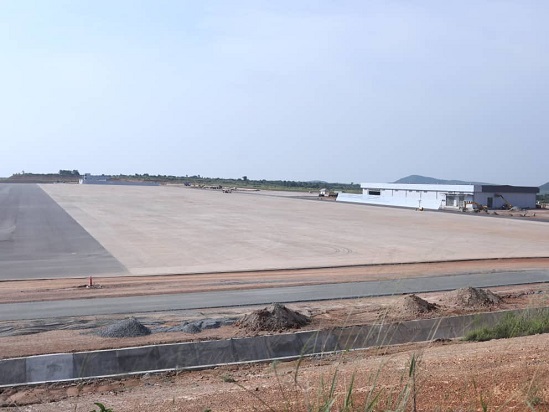Kabalega International Airport is nearing completion
Kabalega International Airport, Uganda’s second international airport after Entebbe, will be ready to start air cargo operations by October 2023, the contractor has said.
Located in Kabalega Industrial Park in Hoima district, the airport will be used to airlift the equipment that will be used in the construction of the oil refinery. The aircargo operations will also pave way for further investments and activities in the industrial park.
Amos Muriisa, the Public Relations Officer at SBC (U) Ltd, the contractors of Kabalega International Airport, says the airport was supposed to be completed in February 2023, but due to the disruptions caused by the rain and the outbreak of the COVID-19 pandemic, the contractor asked for more time to deliver the airport.
“Due to COVID Standard Operating Procedures, in an area where we were supposed to deploy 50 people, we would deploy 25 to observe the social distancing. This affected our site progress that we had to go slightly behind our schedule,” he said, adding that the company has claimed the time lost and have been given more eight months to complete the work.
“We are expecting to see this project completed by October. By this period (October 2023), the airport will be ready to handle any flight,” he said.
Muriisa made the remarks during a media guided tour of the ongoing airport construction works on Wednesday afternoon, where he revealed that the airport is now 91.75% complete.
The €309m (Shs1.25 trillion) project is funded by United Kingdom Export Finance by 85% and 15% by the Government of Uganda.
Muriisa says the construction of the airport alone will utilize €264m, while the rest is for administration and consultancy.
He says the airport was constructed in a phased.
“We have phase one and phase two. By October 2023, the airport will not be totally completed but it will be in position to handle the flights. To be complete, we shall need 20 housing units for the airport operators, we shall need the air control tower, a fuel farm/depot but they are not as urgent as possible. They can come in the second phase. What is on the ground is what is required to have the airport start operating,” Muriisa said.

Asked how the airport can operate without a control tower, Muriisa said, the control tower is a very important component, but it will not affect their timelines and those of the oil and gas industry, noting that the flights will in the meantime be controlled using gadgets at Entebbe International Airport.
“When this airport is ready to start operations, they will use some gadgets in Entebbe, connect them here and control the flights for the time being as Government mobilizes funds for a fixed control tower on this site,” he said, adding that the control tower will be set up in the second phase.
He says the airport can handle any flights “today because the key infrastructure on the airport which is the runway is 99% complete.”
“We are only remaining with marking. So, if there happens to be some equipment to be delivered today, we are ready to handle,” he said.
He says the runway which is 3.5km (length) and 75 meters (width) is 99% complete and the only remaining part is markings.
The other component of the airport which is 100% complete is the apron (parking yard for the planes). It (runway) has two turn pads on the either side.
“The apron has capacity to accommodate the four biggest cargo planes in the world at the same time,” he said, adding that the cargo terminal building which will also work as the passenger terminal building for sometime is almost complete, withing finishing works ongoing.
He says there’s no huge storage building on site because the ‘huge and tall equipment’ for the refinery will upon delivery be pushed straight to the site where they’re going to be used (it’s adjacent to the terminal).
He adds that the tax way connecting the runway to the apron is also complete. The air rescue fire fighting facility for emergency response and the air ground lighting house are also in place.
He says the passenger terminal will be expanded in the second phase to handle a big number of passengers.
“The current cargo terminal has the capacity to handle about 1000 passengers in a day and these will mainly be the crew accompanying the cargo. For the time being, there may not be serious passenger flights. There’s space reserved for the expansion of the passenger terminal as well as the cargo terminal,” he says.
More Industries in-offing
Gloria Sebikari, the Manager, Corporate Affairs & Public Relations at Petroleum Authority of Uganda (PAU) , says the oil and gas sector has led to the construction of several infrastructures not only in Bunyoro, but the country at large and these will support agriculture, tourism and the country’s industrialization agenda. She says Kabalega International Airport will also also promote exports especially agricultural produce and value added products, but it will also decongest Entebbe Airport.
Sarah Birungi Banage, the Head of Public Affairs at Uganda National Oil Company (UNOC), said that the refinery will have byproducts that will pave way for the petrol-chemical industries.
“The plastics, the tooth brush, the rubber on your shoes, the inputs in paint, the detergents and cosmetics have an element of petrol-chemicals,” Banage says.
Stella Birungi, the Physical Planning Officer at UNOC, revealed that the Kabalega Industrial Park which sits on 29.5 square kilometers of land, will have many facilities including a refinery, other industries that will feed off the refinery, agro-zone that will have industries adding value to agricultural produce purposely for export and cold rooms. She adds that the industrial park will be self-sustaining because it will have a power sub-station, water, schools, roads, a health centre and a technology campus among others.
“So far, we are into consultancies for most of the infrastructures to be located within the industrial park,” she said, adding by the end of the next calendar year, most key infrastructures like roads will be in place.
About Uganda’s Oil
Uganda is expected to have its first oil in 2025.
The country has 6.5 billion barrels of discovered oil and about 1.7 billion of these are recoverable.
The Kingfisher project which is managed by CNOOC Uganda and located on the shores of Lake Albert in Kikuube district, will produce 40,000 barrels of oil per day at peak, while the Tilenga project which is managed by TotalEnergies EP Uganda and located in Buliisa district will produce 190,000 barrels per day.






